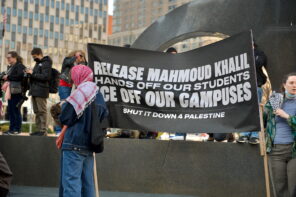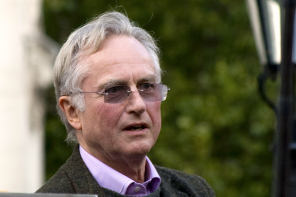This article is part of It’s Your Fault, The Cubit’s series on blame in contemporary society. In this essay, RD associate editor Michael Schulson analyzes the patterns of blame that emerge in the aftermath of religious and ideological violence.
For more on blame, read the introductory post or explore the full series.
Less than a day after the attack on the Charlie Hebdo offices in Paris, George Packer published a post on the The New Yorker’s website titled “The Blame for the Charlie Hebdo Murders,” in which he explained that:
The murders today in Paris are not a result of France’s failure to assimilate two generations of Muslim immigrants from its former colonies. They’re not about French military action….They’re not part of some general wave of nihilistic violence in the economically depressed, socially atomized, morally hollow West…They are only the latest blows delivered by an ideology that has sought to achieve power through terror for decades.
For a while now, I’ve been wondering: how did George Packer know?
As a staff writer for The New Yorker his editors surely expect him to be able to support even claims made in an op-ed. But when Packer published “The Blame for the Charlie Hebdo Murders,” virtually nothing was known about the attackers. The two men had not released any statements about their motives. In fact, the most they would ever say, before dying two days later, was that a desire for revenge had motivated their attack.
But let’s say the attackers had published a manifesto the day of their attack, along with in-depth autobiographies and an affidavit stating, “Islamism motivated us.” Even then, would they have been trustworthy sources? Criminals often cite motives—God told me to do it; He looked at me funny—that seem to provide false or incomplete explanations for their crimes. It’s not clear how Packer could have disentangled all the different elements that might lead someone to kill, and point to one of them—ideology—as the single causal factor.
To be fair, facts weren’t exactly the point of Packer’s article. (He has since described the piece as “too-quick,” adding “I think I’d still stand by it”). With characteristic foresight, Packer was sketching out the lines of a debate that would play out over the coming weeks, one that revolved around whether French society or Islamism was to blame for the Paris attacks.
Some version of this argument emerges after any high-profile act of religious or ideological violence against Westerners, whether in Paris, Jerusalem or Charleston, S.C.
In the aftermath of such an attack, there’s a rush to explain it, usually according to one of three causes: ideology, psychology, or society. The explanations appear almost instantaneously, and they generally reflect more about the interest and ideology of the explainer than they do the actual evidence of the case.
On the one side are those who argue that dangerous ideas are to blame for bloodshed—that worldviews can infect and control people’s minds, like a parasite. New Atheist thinkers, such as Sam Harris and Richard Dawkins, have been especially strong proponents of this position after acts of religious violence.
Packer took up that line of thinking in his post-Hebdo op-ed. So did many people in the wake of the Charleston shooting who emphasized that white supremacist ideology was to blame for Roof’s actions; or those who, after Elliot Rodger’s shooting spree in California, blamed white male privilege.
I don’t mean to equate Islamism with patriarchy and white supremacy. “Islamism,” which reflects a fairly specific set of institutions and political positions, is regularly used as code for “most of Islam.” And those who obsesses about Islamism often flirt with more bald-faced statements of Islamophobia.
Critics of white supremacy and patriarchy, on the other hand, point out that these ideologies are pervasive in the culture at large. The blame casts a wide net, not in order to single out a minority group, but in order to implicate a culture that’s been saturated with these ideas.
In short, not all ideological blame is alike. But there is a common thread here in the tendency to focus exclusively on ideas as the motivation for an attack. That focus can be revealing, because ideology alone never fully explains violence. Plenty of virulent white supremacists and violence-promoting Islamists and privileged men never come close to killing anyone.
Others direct their blame toward forces that emerge from within the individual. Mental illness is frequently blamed for acts of violence, especially by those who share ideological affiliations with the perpetrator. According to this logic, violent acts are committed by crazed persons who just so happen to be gun advocates, or Muslim, or champions of the Confederacy. But the lines of sanity can be difficult to define after bloodshed, and it seems obtuse to claim that a professed ideology played no role in an act of violence.
Still others blame dysfunctional societies. Karen Armstrong, for example, argues in Fields of Blood that colonialism underlies contemporary religious violence, not the religions themselves. Others will claim that oppression is the cause of violence among young Muslims in France, or that economic downturns and disempowerment should be blamed for right-wing violence.
Ideology, mental illness, and social problems all do contribute to bloodshed, of course. What’s strange is that we make sense of violence in such monolithic terms, and often with so little evidence. But it’s worth dissecting the peculiar terms of the debate that emerges after these highly public, tragic spectacles. Doing so highlights the extraordinarily low standards that we often accept in the analysis of blame.
Getting to know everything you don’t know
Which brings me back to my original question. In the hours after an attack, how do the George Packers of the world know what’s really to blame for the violence?
The answer, of course, is that they don’t.
In part, that’s because the evidence is so sparse. The perpetrators often have died. While alive, they’ve rarely evinced any serious intellectual foundation for their actions. Maybe society is to blame, but it’s hard to pin down any concrete connection between social conditions and a given act of terror; while social science identifies patterns, it can rarely tell us where the blame lies in any specific instance.
In a recent essay for The Atlantic, criminologist Simon Cottee challenges the idea that we can ever fully understand why someone becomes a terrorist. “Everyone from clerics to caustic cab drivers seems to have a confident opinion on the subject,” he writes, “as though the interior world of terrorists can be easily mined and mapped.”
But, Cottee continues:
this confidence is often misplaced, given how little scholars actually know about terrorism and the people who are involved in it. It also betrays an epic obliviousness about just how difficult it is to access the internal, subjective desires and emotions that shape the outer world.
Mind-reading is difficult, and the patterns of terror are hard to map. Two people can share identical beliefs, social conditions, or backgrounds, while only one of them turns to violence. Conversely, identical forms of violence—for example, mass shootings—are enacted by people with radically opposed beliefs, and from a range of social positions.
One person can be considered mentally ill, and the other not, and they can kill in similar ways
And so on. There’s no definite logic to these tragedies; no single mental, ideological, or social disposition that every perpetrator shares. And yet none of this stops the speculation. Cottee is homing in on a broader culture of post-tragedy blame, in which everyone takes a crack at making sense of events that, in their particularities, border on the inscrutable.
So why bother to hash it out at all? As is so often the case, the act of assigning blame tells us more about the blamer than it does about society. Where evidence is absent, preconceptions—or, to use a less euphemistic term, prejudices—have room to roam.
As a small library of commentary has documented, Western observers are often quicker to blame Islam for an attack by a self-professed Muslim than they are to blame Christianity for a similar attack by a self-professed Christian.
Observers also seem to blame mental illness more readily when the perpetrator is white. At Salon, Arthur Chu notices this phenomenon in the reactions to the Charleston shooting. Norwegian writer and politician Shoaib Sultan made a similar point earlier this year in reference to the Anders Breivik terrorist attack from 2011. “If [Breivik’s attack] had been done by a Muslim guy, we would never have this prolonged discussion about mental health,” Sultan told The New York Review of Books. (Courts have declared that Breivik, a white supremacist, is sane).
And, based on my own feelings, I would hazard a guess that many who feel that white supremacy is to blame for Dylann Roof’s actions in Charleston were more hesitant, a few months ago, to argue that Islamism was to blame for the attacks in Paris. (Again, the two ideologies are not equivalent; the question is how much we privilege the power of ideas in our analysis of the blame).
Motives are not causes
The problem, perhaps, is that we’ve confused the lawyer’s question about motive with the social scientist’s concern about underlying cause. Both are models for understanding cause-and-effect, but their goals—and standards—are not the same.
At its root, motive is a narrative tool. It lets us transform a tangled set of events into a coherent story, with some logical sequence of cause-and-effect that propels the action forward. In a court of law, that understanding of motivation is enough to let us arrive at a socially accepted account of the tragedy.
On the surface, motive is often easy to figure out. It’s possible to take the perpetrator’s claims at face value, and leave it at that. Courts don’t need to unravel all the sociological, psychological, and historical reasons for hatred. They’re content to say “He hated his boss, so he killed him.”
There are limits, here. Motives are useful within the context of criminal justice, but they do not provide very good grounds for making predictions. Nor can they account for the entire range of factors that contribute to violence. In other words, while they help us tell a good story, they don’t necessarily help us understand the full chain of cause-and-effect that leads to violence.
Those underlying mechanisms are much harder to identify, because the perpetrators’ statements may not give you a complete picture. Violence can have multiple causes, and the relationships between them can be difficult to identify and unravel. Other challenges emerge when you try to connect individual cases to the larger phenomena documented by social scientists. Much as we want to apply general patterns to specific cases, it never quite works. There’s a kernel of rage and mystery at the core of any individual violent crime.
In public conversations after big attacks, we claim to have the objectivity and depth of the social scientist. But we use the standards of the courtroom jury. The result is a kind of public trial—a process of blaming that sounds rigorous, but seems to concern itself more with shaping the narrative than actually understanding the mechanisms behind violence.
Is that imprecision such a bad thing? Dylann Roof’s attack, for example, has been used to highlight persistent racism in American society, and to challenge the Confederate flag. That’s certainly a positive consequence of a terrible event, even if nobody really has any idea what went on in Roof’s head.
Still, there are reasons to pause before we all go groping for motives.
For one thing, while motives tend to be singular, underlying causes are always plural.
Honest responses have to pay attention to multiple causes, instead of collapsing reality to a single motive in order to serve political agendas.
More troubling is that this rapid-fire blame cycle often plays into the hands of those who support terror. The great fantasy of terrorism, after all, is that violence is coherent, and that it can be used to express and advance an agenda—that, in short, violence is a legitimate form of speech. Ideologies bolster that fantasy. They outline a structure of motives. They tell us exactly what and whom we should blame or praise, depending on our perspective. They create narratives to justify violence. In doing so, they suggest that bloodshed is something other than a cruel and selfish act.
To explain the motives for terrorism is often to buy into that narrative. After the Charlie Hebdo murders, for example, when George Packer argued that ideology was to blame, some of the people likeliest to agree with him were probably members of al Qaeda. Blame is more closely related to justification than we often admit. Both seek clarity.
In response, we might want to acknowledge—regularly, forcefully—everything that we do not know about a given act of bloodshed. And while it’s important to recognize larger patterns, when it comes to our conversations about any individual attack, we can assert—regularly, forcefully—the narrow-minded incoherence of violence.
What gets lost among all this talk of society, ideology, and psychology is the role of individual responsibility. Again and again, our blame renders the perpetrator irrelevant—the object of some larger force rather than a selfish individual maximizing his own desires.
Yes, of course: people are subject to forces outside their own conscious control. But not always, and not necessarily. There are (tangled) personal goals that can be achieved through killing. We live in a culture that widely celebrates and honors violence. Yet we find it hard to understand why someone might live out his or her particular personal fantasies through bloodshed.
Fantasy and desire, intersecting with ideas, societies, psychoses: what could be more personal, more individualized, more petty, more terrible? But terrorism is spectacle. The individual kills; the ensuing cycle of attribution and blame elevates the individual to a symbol; we negotiate the meaning of that symbol, and move on. Can blame help us achieve our political aims? Sure. But there’s a price, because in the process, we invest additional power in those people whom we least want to lift up.














